- About Us
- Columns
- Letters
- Cartoons
- The Udder Limits
- Archives
- Ezy Reading Archive
- 2024 Cud Archives
- 2023 Cud Archives
- 2022 Cud Archives
- 2021 Cud Archives
- 2020 Cud Archives
- 2015-2019
- 2010-2014
- 2004-2009
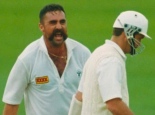 |
The 1989 Ashes Revisited |
The 2009 Ashes Series was not memorable for Australians, not least because we lost. Losing aside, there were few standout performances by either team. One notable performance was a debut knock of 119 by Jonathan Trott to set England up for the Fifth Test win – not the first time that we’d suffered at the hands of a South African disguised in British colours. Other notables included Kevin Pietersen, out for 69 at Cardiff attempting a very inappropriate paddle sweep off a Nathan Hauritz delivery. The top edge bounced of Pietersen’s head and into the hands of Simon Katich at short leg. Looking at the replays you can see Pietersen committed to the delicate move well in advance of Hauritz, an act of premeditated batting suicide for which he was unrepentant.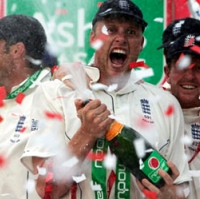 Australia’s ‘keeper Brad Haddin, by injuring his finger in the warm up and ruled out of games 3 and 4, contributed his own answer to the age old question as to whether cricketers should warm up with a game of footy.
Australia’s ‘keeper Brad Haddin, by injuring his finger in the warm up and ruled out of games 3 and 4, contributed his own answer to the age old question as to whether cricketers should warm up with a game of footy.
There was a flourish, a glimmer of hope for the Australians in the Fourth Test at Headingley, but mean reversion took hold and by the end of the Fifth Test the baggy green was looking decidedly crumpled. Not even the under strength English team, with Freddy Flintoff injured and Pietersen off the boil, could spare our boys the humiliation of coming home empty handed.
On the commentating front it is worth noting that, this year Channel Nine’s mainstay commentary team were superseded by a much slicker and younger SBS outfit including Damien Martyn, Greg ‘Mo’ Matthews and Stuart MacGill. The cream, the beige, the bone, the ivory and the off white were replaced by sharp-looking cats with shock commentary, in-jokes and advanced hair (I must confess, I have always been secretly impressed by Mo’s do and this year I looked them up on the web).
For the seasoned couch denizen the Channel Nine commentary box, despite its many flaws, fits like a well worn glove. You pick it up where you left off last summer. It’s always been a source of comfort amidst uncertain economic conditions and national crises. Richie Benaud’s or Ian Healy’s dapper and understated deliveries are unmatched as is the subtle but persistent niggle between Bill Lawry and Tony Greig. The eloquent banter and mostly accurate calls, disagreements, the occasional non-PC gaffe or some barely audible swearing in the background, interspersed with more than a healthy dose of statistics and cheesy left-over-paraphernalia-winning quizzes.
The first hint of the famous Channel Nine intro music, in any given summer signalled it was time to replace the batteries in the remote control and fix the Dawson chair, make sure the Barbie works, relocate the esky from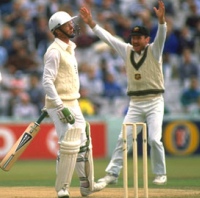 the shed to the living room and pick up a few cases from the bottle-o. Benaud and co’s absence was notable for the 2009 Ashes and the gravitas, for this punter at least was up there with the Wide World of Sports going off air in the 1990’s (RIP Sunday afternoons).
the shed to the living room and pick up a few cases from the bottle-o. Benaud and co’s absence was notable for the 2009 Ashes and the gravitas, for this punter at least was up there with the Wide World of Sports going off air in the 1990’s (RIP Sunday afternoons).
In order to boost morale, and on occasion of its 20 year anniversary, I’ve decided to revisit the glory of the iconic 1989 Australian tour of England. The tour that paved the way for eight successive Ashes wins from 1989 to 2003, under the captaincies of Allan Border, Mark Taylor and Steve Waugh.
The 1989 Series was particularly notable for three reasons: the beer drinking, the sledging and not least the cricket. David Boon broke the world record for number of tinnies drunk on a plane, many cutting and creative remarks passed across the lines, and Australia cleaned up with a comprehensive 4-0 demolition reminiscent of the ‘invincibles’ 1948 Ashes Series.
Underdone, but thirsty.
The Australian team came into the 1989 Ashes Series as underdogs. They had lost to the West Indies at home that summer and had lost the last two Ashes series. Accordingly the English media had written the team off as the “worst Australian Ashes Team ever fielded”. Many Australian players we now regard as heroes were then yet to be tested and had their best years before them. At the time, Border, his own captaincy under pressure, was trying to bring a new team together for the tour.
The nation’s hopes weighed heavily on the team that embarked on QF-151 for London via Singapore. Looking back, the plane was so weighed down with talent it is surprising it was given clearance for take off. A team that contained a veritable who’s who of Australian cricketing royalty, including Allan Border (Captain), Mark Taylor, Steve Waugh, Geoff Marsh, David Boon, Dean Jones, Terry Alderman, Ian Healy and Merv Hughes. A notable exception was Shane Warne; the 1989 tour predated the iron swinging, wife cheating and camera smashing chain smoker by 3 or 4 years.
The 1989 team was aptly described by Bruce Campbell, a blogger of some renown:
“Men whose amazing deeds in the battle for the urn have excited us all. Men with slightly large waistlines, questionable facial hair and not always meeting the description of an ‘elite athlete’”.
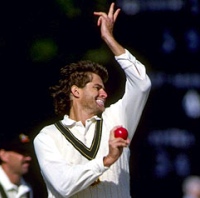
The sort of athletes who inspire us all to achieve sporting prowess without compromising our lifestyles.
So, when the team saddled up for the Sydney-Singapore leg of the flight to London they were thought to be very underdone.
Boonie was also thirsty.
But it was no ordinary thirst. It was a thirst that had been growing for 28 years from deep in the heart of Van Diemen’s Land, with as much strength as the roaring forties lash the Tasmanian west coast.
A thirst of god-like or perhaps more accurately keg-like proportions.
And it was a thirst that no ordinary drink would slake….
As the famous advert goes, you can get it milking a cow, you can get it working a plow, you can get it any old how. Boonie might not have it now and no one knows precisely how he had it, but he had it then. Boonie’s deep thirst symbolised the team’s thirst for victory, a win at all costs mentality, and it would unite them to lift together to achieve the extraordinary, on and off the pitch.
A very thirsty Boonie belted up ready for takeoff. Dean Jones, a newcomer to the team had opportunistically sited himself next to Boonie. According to Jones, his (Jones) old man Barney had told him sit next to Boonie so he could learn some inside knowledge on tours, county cricket and England’s bowlers. Jones received another type of lesson altogether.
For the record.
At some stage in history someone thought it was a good idea to become excessively inebriated on cricket tour flights. As these things invariably do it became a competition. The plot was hatched during a precocious attempt to drink as many beers as possible on the way back from the Australian tour of the Caribbean in 1973. Thirsty from a hard series under the hot Caribbean sun, Doug Walters and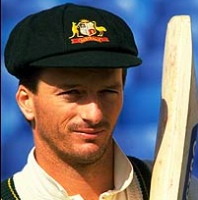 wicketkeeper Rod Marsh made a friendly wager to see who could knock over the most beers between Kingston and Sydney. The results of that competition are unknown, but without doubt a tidy tally was tucked away by touchdown in Sydney.
wicketkeeper Rod Marsh made a friendly wager to see who could knock over the most beers between Kingston and Sydney. The results of that competition are unknown, but without doubt a tidy tally was tucked away by touchdown in Sydney.
By the 1977 Ashes tour the competition had wider appeal. This time everyone was in on it, players, management, journalists and hangers on. Walters, the boy from Dungog, professed to be a ‘sipper’, and spent the early part of the flight from Sydney to London well back in the back. After Bahrain, it was only Marsh and Walters in the running.
Walters slugged down his 44th to set the record as the plane landed in London, Marsh having long since keeled over. Leg spinner and ABC commentator Kerry O’Keefe recounted Walters’ status at Heathrow. “He was all right – just” says O’Keeffe. “He was lighting cigarettes filter-first. I guess that’s all right. You can do that sober”. Marsh raised the bar to 45 in 1983, despite early attempts by Denis Lillee to protectively sabotage his mate’s performance (no doubt to preserve Marsh’s capacity for taking catches).
By 1989 the competition to drink as many cans as possible on the way to England was well established.
Early on in the flight to Singapore, Boonie was tucking into the tinnies. According to Jones, the Qantas staff had been counting Boonie’s progress and early indications were that he was on track for the record.
By Singapore Boonie’s walrus moustache was dripping wet with beer, and the cabin and crew, probably with the exception of Jones, captain Allan Border and coach Bob Simpson, were frothing up for the unfolding action.
At the conclusion of the Sydney-Singapore leg Jones abandoned his fielding position and headed upstairs to curl up in the seat behind Border and Simpson. What happened in the next few hours is foggy, perhaps due to the passing of years or passing of brain cells, but probably because the main raconteur, Jones was not present. Other accounts suggest that a series of players including Merv Hughes, Geoff Marsh and Geoff Lawson took turns riding shotgun with the ‘keg on legs’ to offer encouragement and logistical support.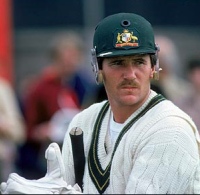
Jones’ account of proceedings picks up when he was woken by screams, cheers and an announcement over the in flight PA that Boonie had broken the record previously set by Rod Marsh. Coach Simpson had a chuckle, thinking someone had cleaned up in a poker game, and remarked on his own successful card playing exploits from some far distant tour. The smile drained from his face when the news reached them. According to Jones: “Simpson went purple with anger and I mentioned to (selector Laurie) Sawle that maybe Boonie should be sent home and I would bat in his spot”.
Boonie pulled the top off number 52 as the plane touched down at Heathrow. A feat made even more impressive by the fact that the effects of the alcohol would have been greater at altitude.
The story goes that Boonie emerged from the 747 solid as a rock, with the weight of a nation’s hopes on his shoulders, and 57[i] beers weighing on his generous girth. The sturdy keg on legs left the plane on his own, more or less, whereas apparently Rod Marsh had to be carried following his 45.
Merv Hughes was unable to contain himself after touch down and proudly announced to the media that Australia had already notched up a half century before the tour started. But in Australia’s hearts and minds the tour had already started. Back at home there were rumours going around that Tasmania’s speed limit would be reduced to 52 km/h. The ABC comedy show ‘The Late Show’ gave Boon the moniker of "Dead-set Legend". In 2005 VB created a digital talking Boonie doll.
At the time Boon was fined $5,000 and was almost sent home. Both Boonie and Hughes were put on probation, Boonie in recognition of his achievements in flight, and Hughes for his forays into stand up comedy and impromptu press releases. Hughes: “I got into more trouble than the protagonist. I was sh----g myself that I would be sent home – it was my first tour and I was on my last chance the moment we reached the first hotel.”
The Sledging.
The 1989 tour was also notable for the colourful exchanges between players out on the 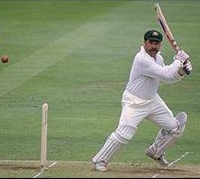 pitch. Prior to departure for England, Ian Chappell had pulled Allan Border aside and told him to be less cosy with the opposition, to sharpen things up a bit. For example, there was nothing more sickening for Australians than seeing Freddy Flintoff lean over to help a sobbing Brett Lee to his feet after the lost 2005 Ashes tour. Many argue that recent Ashes tours have been characterised by too much bonhomie and that has taken a lot of the edge out of the game.
pitch. Prior to departure for England, Ian Chappell had pulled Allan Border aside and told him to be less cosy with the opposition, to sharpen things up a bit. For example, there was nothing more sickening for Australians than seeing Freddy Flintoff lean over to help a sobbing Brett Lee to his feet after the lost 2005 Ashes tour. Many argue that recent Ashes tours have been characterised by too much bonhomie and that has taken a lot of the edge out of the game.
Accordingly, in the First Test in 1989 Robin Smith was injured and asked if a drink could be sent out, to which Border replied: "What do you think this is, a f---ing tea party? You can f---ing wait like the rest of us."
Later when Smith missed a Hughes delivery, Hughes sledged: "You can't f----g bat." Smith provided a great response with a sizzling four. The verbal response was even greater: "Hey Merv, we make a fine pair. I can't f---g bat & you can't f----g bowl."
Another pearler from Hughes, probably directed at Smith: "Mate, if you just turn the bat over you'll find the instructions on the other side".
At the end of the tour, British opener Michael Atherton commented on Hughes: “I couldn't work out what he was saying, except that every sledge ended with ‘a---wipe’.”
Hughes and Smith were reunited on the next tour. Hughes: "It's four years since I bowled to you and you haven't improved". The next ball goes for four, Smith responds: "Neither have you".
The games.
Australia won the 1989 Series 4-0. If it wasn’t for the weather it may have been a clean sweep.
The First Test at Headingley in 1989 was marked by Border's defiant innings of 66 and Mark Taylor's 136 - his first Test century. Steve Waugh's 177 not out helped the Aussies to 7/601 in th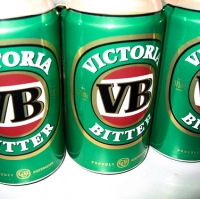 e first innings. Boonie, perhaps still recovering, was out 9 caught behind. Terry ‘Clem’ Alderman bagged a 10 wicket haul.
e first innings. Boonie, perhaps still recovering, was out 9 caught behind. Terry ‘Clem’ Alderman bagged a 10 wicket haul.
Waugh’s majestic innings prompted one observer to remark:
“My personal memories of the series are limited to images of Steve Waugh chewing gum, batting without a helmet and happily flaying bowlers who had no more idea of how to engineer the fall of his wicket than medical science has of curing the common cold.”
The rest of the scorecard reads as follows: 2nd Test at Lord's Cricket Ground – Australia won by 6 wickets (Waugh 152 not out). 3rd Test at Edgbaston – match drawn. 4th Test at Old Trafford – Australia won by 9 wickets. 5th Test at Trent Bridge – Australia won by an innings and 180 runs. 6th Test at The Oval – match drawn.
On to a good thing, Australia used 12 players versus England’s 29. The Aussies were never dismissed for less than 400 in an innings all series. Boonie scored 442 runs at an average of 55.25. Alderman, player of the series, continuously harassed the English batsmen with his persistent probing in the ‘corridor of uncertainty’, claiming 19 lbw wickets for the series (41 wickets in total). Mark Taylor bagged one double century, one century and five half centuries and finished the tour with an average of 83.9. His 830 runs for the series was at the time the second highest Ashes Series run haul after Don Bradman’s 974 in 1930. Waugh finished the series with an average of 126.50, the fourth highest Ashes Series average.
According to the Wisden report: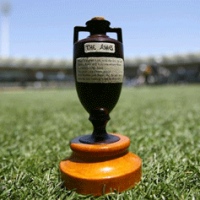
“But for loss of playing time through rain and bad light there [6th Test @ The Oval], and in the Third Test at Edgbaston, Australia’s four-love winning margin might easily have been six-love; and with a single reservation, many of those who saw every Test would have considered they deserved it. It had been a long time since the development of a series – any series – had been so much at variance with general prediction.”
But the cricket was perhaps secondary to arguably the most famous achievement of the tour. It is ironic that Boonie is now the face of the anti drink driving campaign in Tasmania and is on the board of the alcohol abuse program.
The 2009 Ashes Series didn’t have the beer (although there are rumours of some pretty extreme British celebrations post Series), the sledging or the wins. Perhaps it wasn’t the beer or the sledging, but the 1989 team were desperate for the win. They were as thirsty for victory as they were for the beers, and Border’s win at all costs mentality, and the pressure for results, could be what was missing from the most recent excursion to England.
[i] Not well known is that a few more were had in Melbourne and Singapore, although only drinks consumed in flight counted towards the tally.
